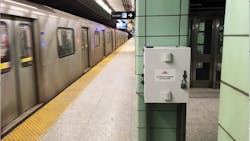TTC subway air quality has ‘improved substantially’ in past 10 years, new study finds
According to a new report from Health Canada, the National Research Council of Canada and the University of Toronto, the Toronto Transit Commission (TTC) has made significant improvements to air quality in the subway system.
The Subway Air Quality Initiative was carried out between 2018 and 2020 and concluded that new trains and updated braking technologies and protocols that reduce friction contributed to reduced levels of fine particulate matter (PM2.5) inside vehicles and on platforms when compared to previous measurements taken in 2011.
A summary of the research is available here.
“This is excellent news for our employees and customers and it confirms that the steps we have taken to date are having a positive impact on air quality,” said Betty Hasserjian, acting chief safety officer, TTC. “We will keep modernizing our infrastructure and our operating procedures to ensure we are continuing to make gains in this area.”
PM2.5 refers to particulate matter that is 2.5 microns or smaller in size. PM2.5 particles are found indoors and outdoors, although their composition varies depending on the setting.
The TTC adopted several long-term measures and strategies that will further improve air quality, including ongoing monitoring and mitigation strategies. One such measure, the implementation of Automatic Train Control (ATC) has optimized the acceleration, deceleration and braking of the subway trains on Line 1. This has reduced the amount of friction during the braking process, leading to a reduction in PM2.5.
“I’m pleased to see the work the TTC is doing has resulted in a lowering of PM2.5 levels in the subway system,” said Toronto Medical Officer of Health Dr. Eileen de Villa. “There are numerous benefits that public transit offers with respect to the city's overall air quality by reducing traffic congestion and associated air pollution.”
As with previous studies, Health Canada did not look at health impacts of the air quality, only the levels of PM2.5. Observed levels fall well below the occupational exposure limits and are now as much as 10,000 times lower than they were in the first such study, conducted in 1995.
The research also found that air quality in Toronto’s subway system is comparable to those found in other large underground rail systems, and in some cases is better than other major subway systems such as New York City and Boston.
